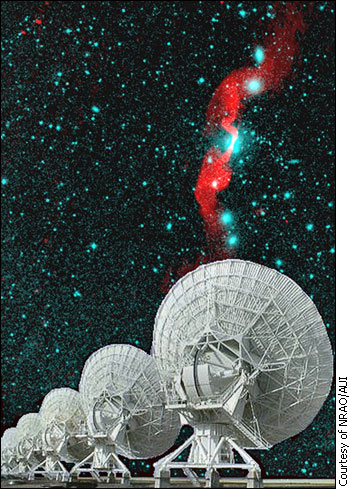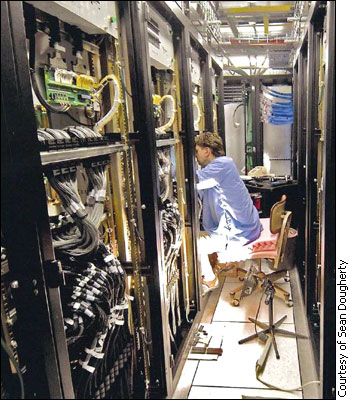 |
| The Expanded VLA will be able to see
even more distant galaxies than its predecessor. |
But this isn’t your average iMac.
In the words of the man overseeing its construction, this
$17-million U.S. machine will be the “biggest, baddest
supercomputer for doing this thing that’s been built
yet.”
And everything about this computer, from the patented technology
that makes it so powerful, to the circuit boards that bring
it to life, will be a Canadian product and may soon allow
astronomers to see deeper into the universe than ever before.
“This is a very high profile instrument,” says
Sean Dougherty, group leader at the Dominion Radio Astronomical
Observatory (DRAO) in Penticton, B.C., which is a branch
of the National Research Council. “This is going to
have a Made in Canada stamp on it, sitting in the middle
of the U.S. I think it’s fantastic that we could get
Canadian engineering put in such a significant instrument
in another country. I think it speaks volumes to Canadian
capability.”
This supercomputer has been built to make sense of the data
being fed to it by the 27 antennae that make up the Very
Large Array (VLA), a group of radio telescopes that have
marked the landscape west of Socorro, New Mexico, since 1980.
In this capacity, a specialized supercomputer is known as
a correlator. And, Dougherty says, Canadians have earned
international recognition as a world leader in building these.
| '[This is the] biggest,
baddest supercomputer for doing this thing that’s
been built yet.' |
When DRAO met VLA
The correlator currently used for the VLA is a genuine vintage
instrument – it’s been in service since the array
was dedicated in 1980. Despite its age, it has helped astronomers
accomplish plenty in its lifespan, says Bill McCutcheon, a professor of astronomy at the University of British Columbia. Still,
he added, without an upgrade, the array would likely be put
out to pasture, as its usefulness declined with its aging
technology.
In 2001, the United States National Science Foundation approved
a 10-year project to upgrade the VLA, including its correlator.
When the upgrade is completed, the array will be known as
the Expanded Very Large Array (EVLA).
The NRC has built these kinds of instruments for as long
as telescope arrays have been in existence – at least
since the mid-1970s, Dougherty says.
“We’ve become very familiar with building instruments
using the latest technologies. In recent years we’ve
completed two outstanding systems that were used for other
projects, not just our own,” he says. Those projects
included contributions to a Japanese satellite project, as
well as upgrades to the James Clerk Maxwell telescope on
Mauna Kea in Hawaii, which is joint operated by the Canadians,
British and Dutch.
The team approached the Americans, proposing to use WIDAR – a
new, Canadian-invented technique that promised to make the
correlator for the VLA more powerful and flexible than any
other currently operating.
“The VLA has been one of the most successful telescopes
in the history of the astronomy and this makes it even more
useful,” says UBC's McCutcheon.
The correlator represents the third largest contribution
to the EVLA in terms of monetary value – the entire
upgrade is budgeted to cost $100 million U.S. – but
the Canadian team isn’t receiving financial compensation.
Science is different from industry, Dougherty explains, and
in return for their contribution, the Canadians will receive
access to other projects and credits for things like telescope
time that would normally be costly to outsiders.
What's next?
After a prototype tested successfully in August 2008, production
has now started on the 256 custom circuit boards that will
make up the correlator. By a happy accident, Dougherty says,
BreconRidge, the company with the manufacturing contract,
is based in Kanata, Ont.
 |
| A Canadian technician
installs racks for the EVLA correlator. The correlator
consists of 256 individual boards. |
The hardware for the system is to be delivered later this
year, and by January 2010, Dougherty says, the National Radio
Astronomy Observatory is expecting the Canadian correlator
to be complete and ready to take over from the old electronics.
Over the next three years, he says, the rest of the system
will be brought online.
So what will astronomers see when they turn on a telescope
that has been given a $100-million lease on life and uses
some of the best technology available today?
Galaxies, hopefully, says Dougherty. And lots of them.
In addition to further understanding the magnetic structure
of the universe, researchers are hoping to discover many
galaxies that have been hidden to the current VLA because
the signals they emit are so specific and constantly shifting
that they have been difficult to pinpoint. With eight gigahertz
and 16,000 channels at their disposal, Dougherty anticipates
that finding the frequencies of these galaxies will no longer
be a problem.
“It’d be like trying to find a needle in a haystack
[with the old VLA], but with this new system, it’d
be dead easy,” he says.
Front page photo courtesy of NRAO/AUI
|

